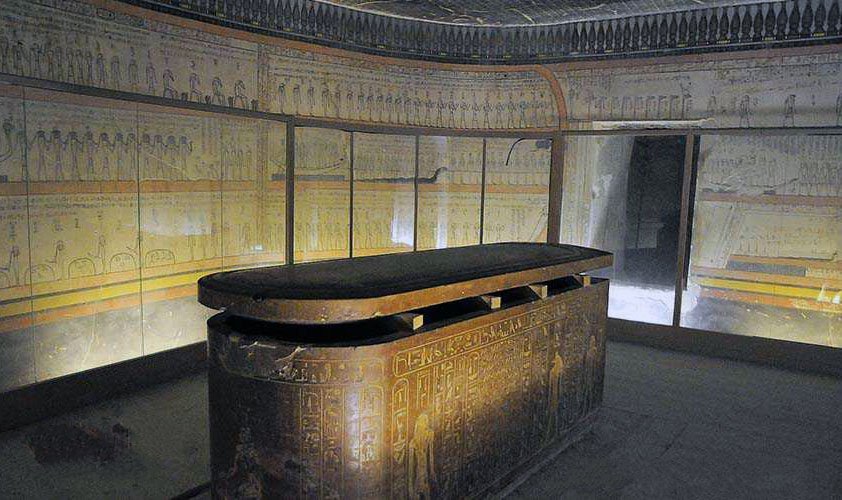
The tomb of Tuthmosis III (KV 34) is said to be one of the most sophisticated tombs in the Valley of the Kings. Discovered by Victor Loret’s workmen in 1898 during this famous Egyptologist’s absence, work did not begin on clearing the rubble form the entrance until his return. He then excavated the site meticulously, using 24 square grids and recording the placement of even the smallest of objects.
The tomb itself can be found in a narrow gorge at the bottom of the Valley of the Kings. The entrance is 30 meters above ground level, but of course this did not stop ancient tomb robbers, though Loret did find some funerary furniture that had been left behind.
The orientation of the tomb is such that the entrance lies in the north, while the burial chamber deviates to the east, a tradition originating with the Middle Kingdom Pyramid of Sesostris II. This complex path symbolized the region of the netherworld. Typically for this period, but a first for the Valley of the King’s proper, the tomb begins with a stairway, a corridor, a second stairway and a second corridor before reaching the ritual shaft. The ceiling of the ritual shaft is painted with a blue sky and yellow stars. After the ritual shaft, like most tombs of this period, there is a 90 degree turn into the Vestibule, which is then followed by the burial chamber with its four lateral annexes. While the passages are not decorated, other areas were plastered and painted for the first time.
The vestibule has two pillars, and is decorated with the 741 divinities of the Amduat that generate the daily sun. A flight of stairs leads directly from there to the burial chamber, which is oval and also has two pillars. The oval burial chamber is common also to the tombs of Thutmosis I and Thutmosis II. The burial chamber is large, and holds a beautiful red quartzite sarcophagus. However, Tuthmosis III’s mummy was not found here, bur rather in tomb DB 320 at Deir el-Bahri (in 1881).
The walls of the burial chamber are designed like a huge ornamental scroll, with the complete text of the Book of Amduat. The ancient Egyptians called this book the “Book of the Secret Room”. Amduat meant “that which there is in the afterlife”, and the book is divided into twelve parts, representing the hours of the night. On the two square pillars of the burial chamber, and for the first time, we find passages from the Litanies of Re on seven of the surfaces, and on the eighth a unique scene in which the king is shown being nursed by a divine tree goddess labeled “Isis”. It is likely, however, that these pillar decorations were added hastily, after the king’s death.
This tomb had been brutally plundered by reckless robbers. They took no care whatsoever to prevent damage, and in some instances demonstrated almost a violent hatred, throwing objects forcefully against the walls, where traces of gold foil may still be seen. The principal item of funerary equipment found in the tomb was the sarcophagus. Other items included a number of wooden statues of the king and various deities, pieces of wooden model boats, pottery and bones from a baboon and a bull. However, a foundation deposit was also discovered that contained model tools, plaques and vessels. A number of other items from the tomb were also discovered by Daressy, Carter and John Romer in other areas of the Valley of the Kings.
Leave a Reply